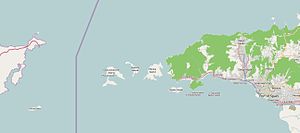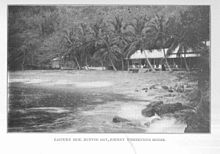Huevos
| Huevos | |
|---|---|
| Huevos (center), Chacachacare behind, Venezuelan mainland behind right | |
| Waters | Dragon's Mouth Strait, Caribbean Sea |
| Archipelago | Bocas Islands |
| Geographical location | 10 ° 42 ′ 0 ″ N , 61 ° 43 ′ 0 ″ W |
| surface | 1 km² |
| Highest elevation | 0.18 m |
| Residents | uninhabited |
Huevos is an island belonging to Trinidad and Tobago and belongs to the group of Bocas Islands . Administratively, the island of Huevos belongs to the Diego Martin region . The island is privately owned.
geography
The Bocas Islands are off the Chaguaramas in the northwest of the island of Trinidad . The chain of islands (consisting of Chacachacare , Huevos and Monos ) lies between Venezuela and Trinidad in the Dragon's Mouth Strait (Bocas del Dragón), which forms the northern limit of the Gulf of Paria to the Caribbean Sea . There are smaller straits between the islands. Huevos is separated from the neighboring island of Chacachacare to the west by the almost 1,300 meter wide Boca de Navios . Between Huevos and the Monos to the east lies the Boca de Huevos with a width of about 1000 meters.
Huevos has the shape of a waxing crescent moon. The northern tip is called Cape Garlio, the southern tip Point de Cabras. In the northern half, the narrow island is almost divided into two parts by two opposite bays on the Boca Sin Entrada . The coastline is lined with steep cliffs, only in Tortue Bay in the south there is a sandy beach, which also offers the only access to the island. The soil of Huevos consists primarily of slate and phyllite .
history
The island was "discovered" in the modern sense in August 1498 by Christopher Columbus as part of his third voyage of discovery. He gave it the name "El Delfin" because of its shape. At that time there was still a freshwater spring on the island, which made it attractive to seafarers. The current name of the island (Spanish for "eggs") supposedly goes back to the hawksbill sea turtle , which used to lay their eggs in large numbers on the beach of Tortue Bay. On August 10, 1800, the British HMS Dromedary ran aground with 500 passengers in the Parasol Rocks, a rock formation off the east coast of Huevos. Everyone on board could be saved. Since 1926, the island has been owned by the Boos merchant family, former world monopoly for the Angosturabitter trade . At the invitation of the family, several members of the British royal family stayed in Boos' villa in Tortue Bay between 1935 and 1965.
Flora and fauna
The flora of the island is characterized by the very low level of precipitation compared to the surrounding mainland. Huevos is u. a. overgrown with yellow poui (Tabebuia serratifolia), pork plum (Spondias mombin) and white gum trees. Flamingo flowers thrive between the trees . The rare fat swallow lived in a cave on the island until at least 1925 , but the population has now disappeared. Roach vireos , yellow-headed caracaras, sugar birds and black vultures can be found all over the island . Numerous types of lizards are native to Huevos, such as B. Gonatodes ceciliae. In the waters around Huevos there are u. a. Surgeonfish (Stripe Surgeonfish, Ocean Surgeonfish, and Blue Surgeonfish ) and Angelfish ( Queen Angelfish , French Angelfish , and Gray Angelfish ).
Web links
Individual evidence
- ^ Paul Shaw: A Register of the Caves of Trinidad and Tobago . University of the West Indies, St. Augustine 2009 ( psu.edu [PDF]).
- ^ Caribbean History Archive
- ^ A b Bonnie J. Tyler: Marine Group Field Trip Report I, in: The Field Naturalist 2/2012, available online
- ^ Caribbean History Archive
- ↑ TheWesterlyTT.com: Huevos, Visits By Royalty and VIPs (1935 To 1965) ( Memento of January 6, 2014 in the Internet Archive )
- ↑ Scribd.com: Observations of Reptiles on Huevos Island ( Memento from January 6, 2014 in the Internet Archive )
- ^ Anthony, Michael: Historical Dictionary of Trinidad and Tobago. Scarecrow Press 2001. ISBN 0-8108-3173-2



